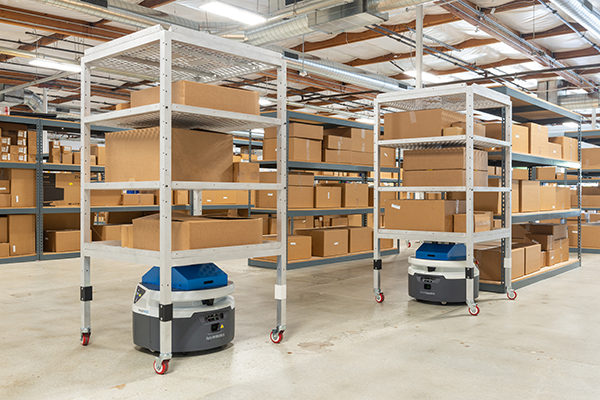Leaders seek warehouse automation solutions to ensure the health and safety of employees while meeting the speed consumers expect.

By Chris Femia, Blue Horseshoe Managing Vice President
Digital transformation was once a pipedream for many industries. More than 50% of B2B executives cite outdated technology and organizational issues as deterrents for transformation. Some executives believe the commitment and execution required would serve as too much of a shock to the established way business is done. Cue a shock much bigger than digital transformation: a global pandemic.
The pandemic has served as the catalyst for the digital transformation of many industries, speeding up the adoption of technology by several years. The supply chain, including a company’s shipping, receiving and warehouse operations, is no exception. In 2020, 57% of industry professionals reported having adopted cutting edge supply chain technologies already, with a predicted 21% increase in the next two years.
As consumers flocked to online shopping, businesses were forced to evaluate their entire supply chains. Operational agility and the ability to share vital information with internal and external partners are now the expectation. However, the need for digital transformation is not exclusive to meeting consumer demands. The supply chain has been confronted with the need to keep employees and warehouse staff safe while improving flexibility and speed of delivery to customers.
Automation has now become a key differentiator in companies’ efforts to support the needs of its warehouse employees. The tools and technology associated with automation help build a solid, digital foundation for businesses to be successful. Common automation tools include warehouse management/execution systems, mobile data collection devices and, of course, robotics. These tools help facilitate the movement of inventory into, within and out of warehouses while keeping an employee’s wellbeing top-of-mind.
As a result of pandemic response measures, social distancing is strictly enforced in most warehouses, often limiting productivity to what employees can accomplish at a distance. For some, an array of more automated solutions is the answer. To fill the void in the number of hands needed to accomplish more repetitive work, robotic shuttles, arms and bots are being implemented. The safety of warehouse employees is critical, but the need to fulfill customer demands remains essential as well.
Prior to COVID-19, automated warehouses were few and far between. Warehouse operators relied on employees to complete jobs with very little, if any automation. As a result, employees came face-to-face with one another to accomplish any number of daily tasks. The need to eliminate unnecessary close personal contact has led some to more seriously consider the need to digitally transform, accelerating the adoption of more automated, arms-length friendly solutions. By increasing automation, employees are kept at a distance from one another, creating a safer overall work environment.
The pandemic is not the only safety risk affecting the industry. Repeated motion and lack of safety in general increases the risk of injury. According to the U.S. Bureau of Labor Statics, the rate of recorded illness and injury per 100 warehouse workers has steadily increased year over year since 2016. Automated solutions are designed to lift heavy and/or often, eliminating unwarranted exertion on the warehouse floor, decreasing the chance of injury.
More than 50% of warehouse employees’ days consist of standing or walking, often accounting for the majority of warehouse injuries every year. Automated solutions not only decrease the amount of steps a warehouse worker takes per day, but increases the amount of inventory moved by 275%. By implementing automated support mechanisms, like autonomous mobile robots, employees experience safer and more consistent workflows. This minimizes physical fatigue, thus preventing injuries.
Often overlooked as a form of fatigue, is the mental toll that repetitive work can have on employees. The combination of physical and mental stressors leads to increased error rates, unsafe work practices, and eventually, rampant turnover. The warehousing industry is among the highest in terms of turnover, with rates between 35% and 40%. The introduction of intelligent automation, helps to remove many of those repetitive tasks and replace them with ones that tend to better stimulate the mind, providing a workplace setting more conducive to creative thought and problem solving.
Ecommerce grew 27.6% worldwide in 2020, with Amazon.com ranking as the most popular ecommerce site among all shoppers. The two-day shipping conglomerate, alongside online grocery pick-up and food delivery services, has created a consumer-expectation for improved speed and accuracy of deliveries. The acceleration in ecommerce has driven warehouses to adopt warehouse automation, along with the appropriate information systems to support them. Automated guided vehicles, automated storage and retrieval systems and intelligent order management and picking systems can help meet the demands that the speed of commerce has created. In short, automation helps consumer-facing companies get the right product, to the right person, at the right time.
More highly automated solutions require time and money. Industry leaders rely on their supply chain partners to provide clear, incremental value in implementing automation-centric solutions. Before the rise in ecommerce, companies felt the return on investment was lengthy and unattainable. Now, industry leaders and warehouse operators see the positive impact automated solutions can have on their warehousing operations, thus decreasing the time to realize true value.
The pandemic has taught us all the art of preparedness. Digital transformation is no longer a distant goal for most companies. Leaders will look to warehouse automation solutions to meet ever-increasing demands while keeping their employees safe and more productive than ever.

About the Author
Chris Femia is a Managing Vice President with Blue Horseshoe Solutions. Chris advises C-level and other top executives at a variety of companies on subjects including supply chain strategy, technology, network and operations design, inventory optimization, ERP/WMS implementation, organizational change management, and supply chain automation solutions. Before entering consulting in 1998, Chris worked in a variety of supply chain positions within the Fortune 100, focusing on 3PL, chemical, and consumer packaged goods.
Scott Ellyson, CEO of East West Manufacturing, brings decades of global manufacturing and supply chain leadership to the conversation. In this episode, he shares practical insights on scaling operations, navigating complexity, and building resilient manufacturing networks in an increasingly connected world.